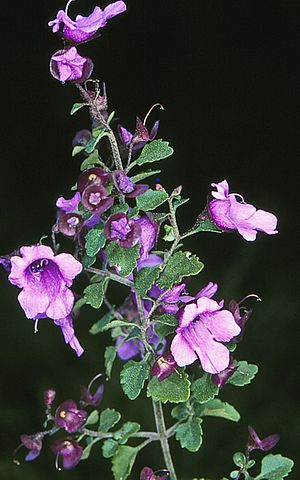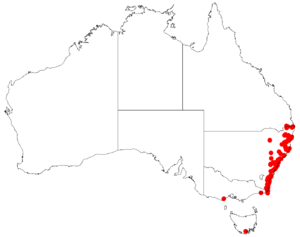Cut-leaf mint-bush facts for kids
Quick facts for kids Cut-leaved mint-bush |
|
|---|---|
 |
|
| Near Bega | |
| Scientific classification | |
| Genus: |
Prostanthera
|
| Species: |
incisa
|
 |
|
| Occurrence data from AVH | |
The Cut-leaved mint-bush (scientific name: Prostanthera incisa) is a special type of flowering plant. It belongs to the mint family, Lamiaceae. This plant grows only in south-eastern Australia. It's a shrub that stands upright and has a strong, minty smell. Its branches are hairy and have tiny glands. The leaves are shaped like eggs or are a bit longer, and its flowers are a pretty pale purple to mauve color.
What Does It Look Like?
The Cut-leaved mint-bush is an upright shrub with branches that spread out. It has a very strong, sometimes unpleasant, minty smell. Its branches are ridged, hairy, and covered in tiny glands.
The leaves are also hairy and glandular. They are shaped like eggs or are a bit longer, usually 8 to 30 millimeters (about 0.3 to 1.2 inches) long and 4 to 12 millimeters (about 0.16 to 0.47 inches) wide. The underside of the leaves is paler. Each leaf has a short stem called a petiole, which is 1 to 10 millimeters long. The edges of the leaves are rough and toothed, and the tip is rounded.
The flowers grow in groups near the ends of the branches. They have small leaf-like parts called bracteoles that fall off as the flower grows. The sepals, which are the green parts that protect the bud, are 3 to 4.5 millimeters long. They form a tube about 2 millimeters long with two lobes, one of which is about 2 millimeters long. The petals are pale mauve to mauve and are 7 to 10 millimeters long.
How It Was Named
The Cut-leaved mint-bush was first officially described in 1810. A botanist named Robert Brown gave it its scientific name, Prostanthera incisa, in his book Prodromus Florae Novae Hollandiae et Insulae Van Diemen. It still has the same name today!
Where Does It Grow?
You can find the Cut-leaved mint-bush along the coast of New South Wales, from Mount Warning near the Queensland border all the way down to Victoria. It also grows in the Central Tablelands of New South Wales.
This plant likes sheltered spots. It often grows at the edges of rainforests or in sclerophyll forests. These are forests with tough-leaved trees like Sydney blue gum (Eucalyptus saligna), cabbage gum (E. amplifolia), Sydney peppermint (E. piperita), red bloodwood (Corymbia gummifera), or turpentine (Syncarpia glomulifera). It can also be found growing near streams with trees like river she-oak (Casuarina cunninghamiana).
Growing Cut-leaved Mint-Bush
People started growing P. incisa in England in 1824. Today, some people grow it on a small scale to get essential oil from it. It's also used as a spice in bushfood.
This plant prefers sheltered places with soil that drains well and is a bit acidic. If the soil stays too wet, the plant can get root rot. It can handle some frost, down to about -5 degrees Celsius (23 degrees Fahrenheit).
The Cut-leaved mint-bush grows quickly. You can harvest it within its first year. If you trim it back to about 50 centimeters (20 inches) tall, it will grow new shoots easily. You can grow new plants from seeds or from cuttings taken from young, firm parts of the plant.

